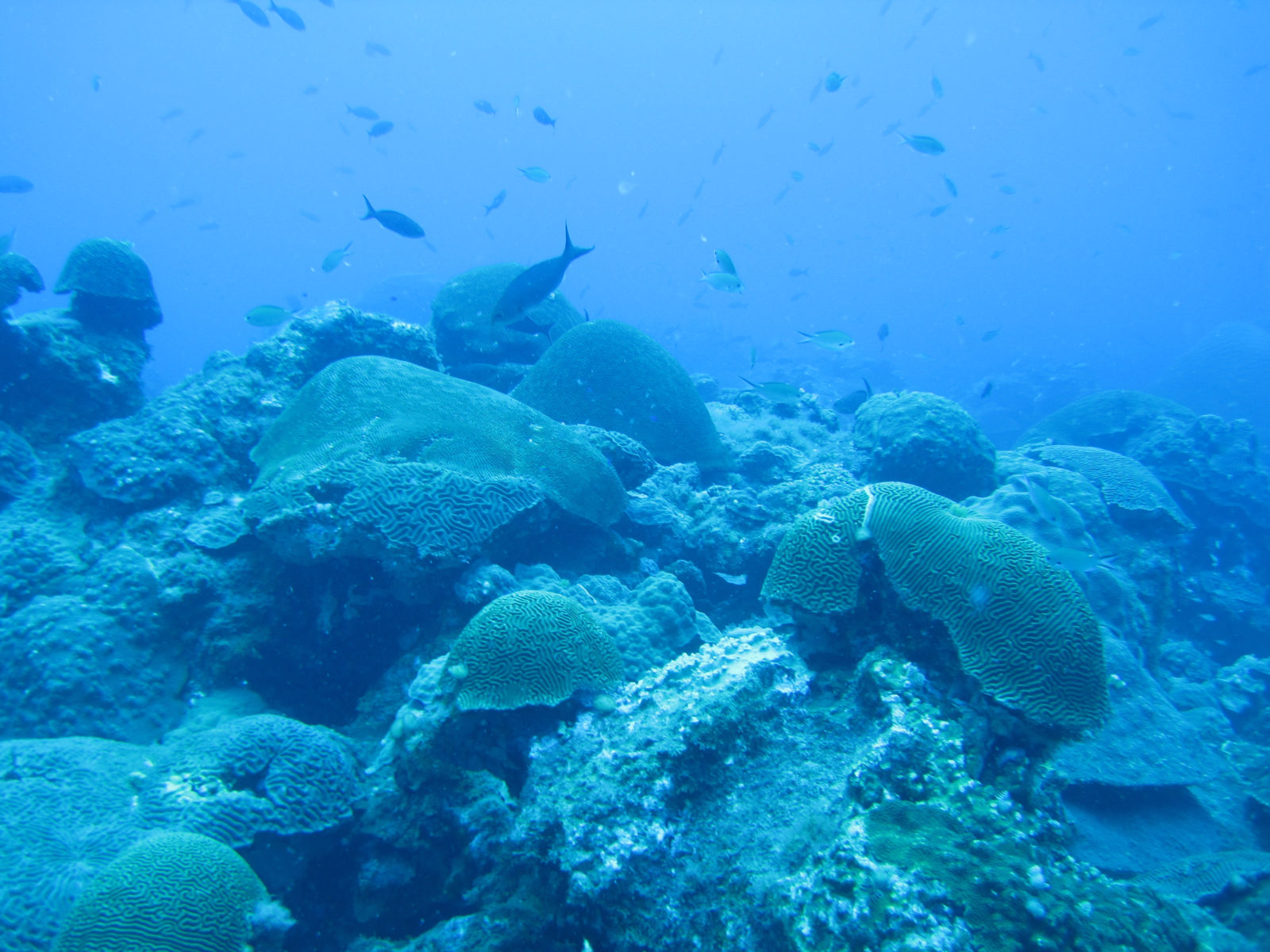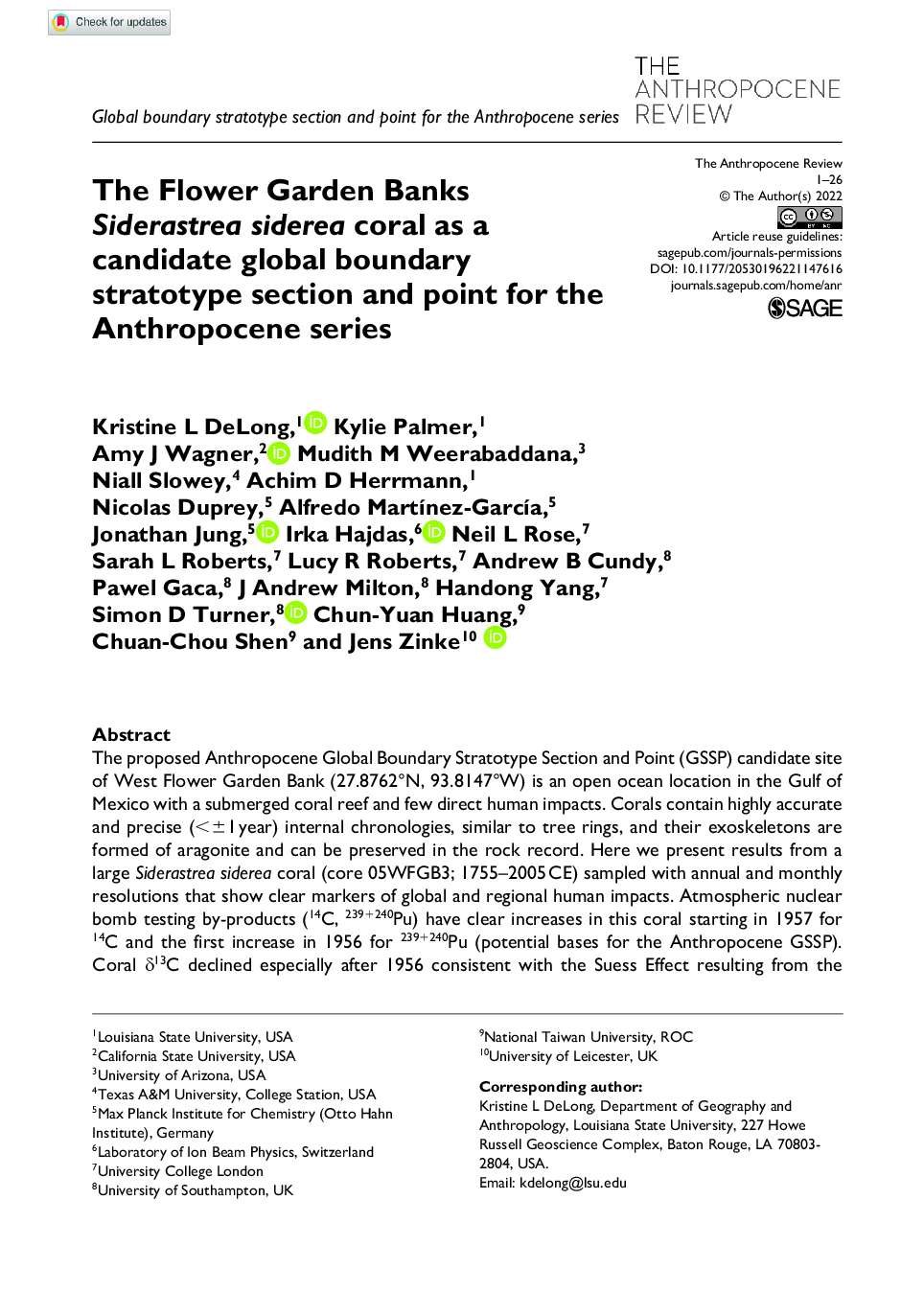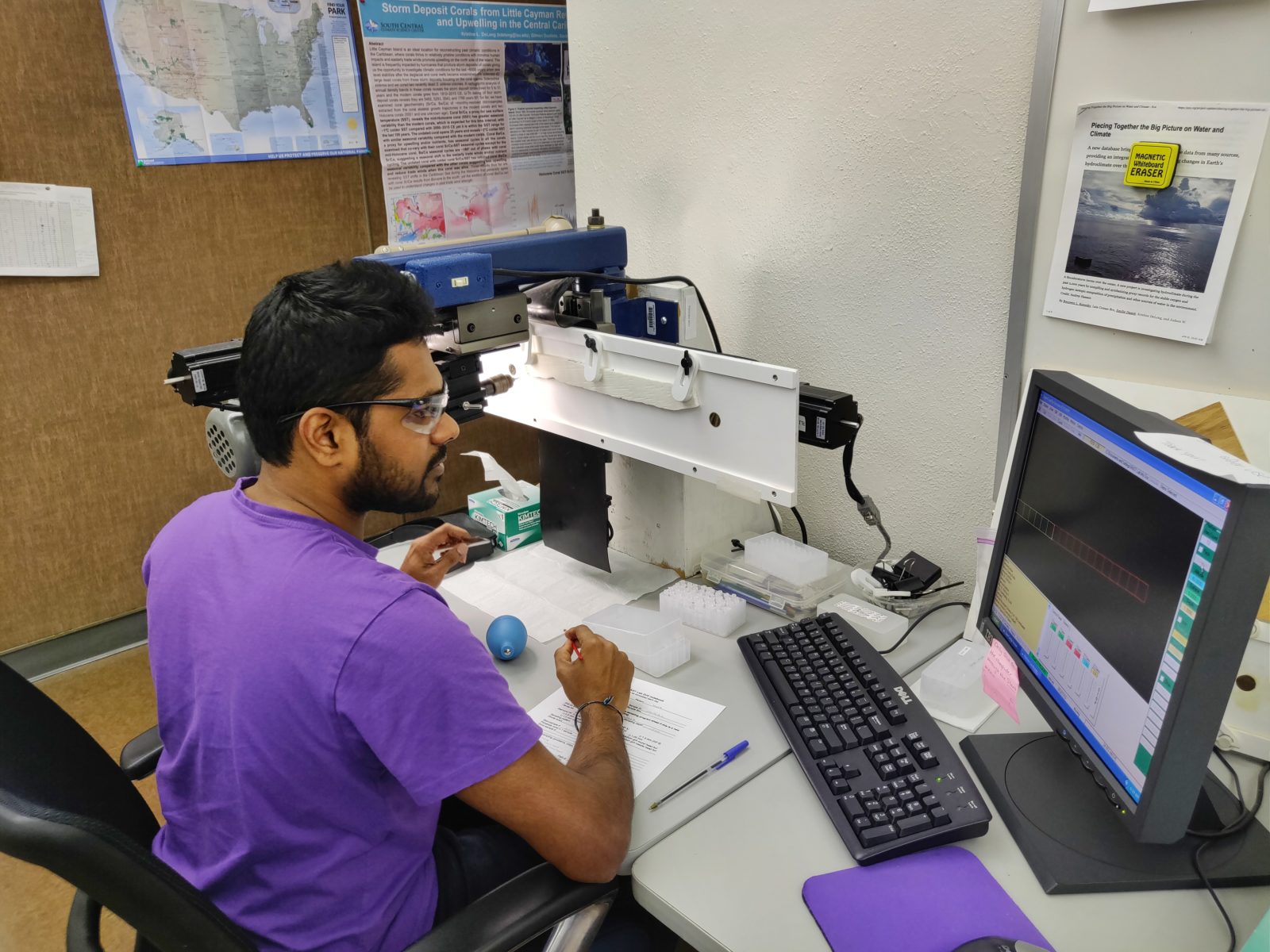West Flower Garden Bank Reef, USA

Site Introduction
The West Flower Garden Bank is a coral reef in the northern Gulf of Mexico, around 190 kilometers from the US coast. At approximately twenty meters below the surface, and extending over ninety-six square kilometers, it is the largest and shallowest of a chain of seventeen banks that are home to an abundance of marine life. Crabs, lobsters, sea stars, urchins, and sea cucumbers roam a landscape of corals, sponges, anemones, and seaweeds, while more than 250 species of fish inhabit the area alongside rays, sharks, sea turtles, jellies, octopuses, and squids.
The reefs in this area are unusually far from the coast, due to their unique formation process. In the Jurassic period—about 190 million years ago—the Gulf of Mexico was a very shallow sea that, thanks to the hot, dry climate, was subject to a lot of evaporation and drying. This resulted in a thick layer of salt being deposited on the seafloor, which was later buried by layers of sand and mud. Because rock salt is less dense than the overlying sediments, it causes the seafloor to bulge upward, especially in places disturbed by deeper tectonic movements (the site lays over the edge of a continental shelf1), forming “salt domes” that rise toward the ocean surface. It is on these salt domes that the reefs have formed during the last 10,000 years, after the Last Glacial Maximum.2
The remote location means that these reefs are less vulnerable than coastal reefs to anthropogenic pollution from the land, and—since it takes ten to twelve hours to reach the reefs by boat—are also less disturbed by fishing and diving. They are not immune to anthropogenic influence, however. The Gulf of Mexico serves as a watershed to a vast area that includes eastern Mexico and two thirds of the continental US, with the Mississippi River Basin accounting for the single largest portion of this catchment. The salt domes also create spaces under the seabed in which oil and gas deposits form—making them attractive sites for petroleum exploration. More than 9,000 offshore platforms have operated in the northern Gulf of Mexico since 1982, including several within thirty kilometers of the reefs.
Location of the Core
The core was taken from a Siderastrea siderea coral colony in the West Flower Garden Bank reef. Siderastrea siderea—also known as the massive starlet coral or round starlet coral—is a stony coral that grows in large boulder-like structures with a mustard-brown color, sometimes reaching more than two meters across. As corals grow, they preserve a record of the water chemistry in their exoskeletons3 that allows scientists to reconstruct past environmental and climatic conditions. Siderastrea siderea is a particularly good species to use for paleoclimate reconstructions, since its relatively slow growth rate means that an average-sized colony is older—and therefore has longer-running records—than similarly sized colonies of other species. Coral exoskeletons are made of aragonite (a mineral form of calcium carbonate), the density of which varies throughout the year as they grow. The resultant annual growth bands (visible in X-ray images) allow scientists to observe individual years of growth in coral cores, and thereby correlate the coral’s skeletal-environmental archive with calendar dates.
Because of the unusual latitude (near the northernmost limits of coral-supporting conditions) and depth (17–40 meters) of these reefs, they have so far been minimally affected by coral bleaching4—a condition caused by rising sea temperatures that is threatening coral reef ecosystems worldwide. This combined with their distance from land (and the human pollutants that originate there) means that these are some of the healthiest coral reefs in US waters, with 50 percent live coral coverage. While coastal corals often record strong traces of human impact from nearby land, the Flower Garden Bank reefs are remote enough to escape much of such influence. Because of this, the mineral and chemical traces they record are more representative of global conditions than local changes, making them a good potential candidate for the Anthropocene GSSP.5 The Flower Garden Banks National Marine Sanctuary is also protected, actively managed, and well studied: regular monitoring of the reefs has occurred since 1972. Meanwhile, the fact that petroleum accumulates under the salt domes means that (partially due to oil company interests) the geology of the region is well documented and understood.
The Core and Results
The 174-centimeter-long core constitutes an archive that extends from 1755 to 2005. The annual growth bands—visible as lighter and darker layers in X-ray images of the core—can be counted to determine the year in which each was formed, with dates verified by thorium-230 radiometric dating.6
The core records traces of fossil fuel combustion, starting in the early 1800s with the burning of coal and then accelerating in the twentieth century with the burning of oil. This is evident in the core in a decrease in carbon isotope ratios (or the Suess effect7). Coral cores also record an indirect effect of the oil industry starting in the 1950s and peaking in the 1980s: an increase in barium in seawater, which may come from the discarded drilling mud (barite) used in ocean oil drilling and/or oil production waters discarded in the surface waters.
The coral skeletons can also record changes in ocean chemistry caused by use of fertilizers on land. Fertilizers contain large amounts of nitrogen and phosphorus, and when runoff from agricultural fields flows into the ocean, the concentrations of these elements in the water increase. Starting in the 1960s, there is an increase of nitrogen in the West Flower Garden Bank core that correlates with nitrogen increase in the Mississippi River (which empties into the Gulf of Mexico). The northern Gulf of Mexico, off the Louisiana coast, is one of the world’s largest “dead zones,” where the increase in nitrogen and phosphorus leads to plankton blooms that deplete oxygen in the bottom waters as the organic matter decays.
Collection and Analysis
Core 05WFGB3-1 was collected in May 2005 at a depth of 23.8 meters by a team of scuba divers using an underwater hydraulic drill, with a 10.2-centimeter-diameter diamond-tipped drill bit. They drilled vertically down from the top of the coral colony. The coral core extraction at this site was challenging, since divers can only remain at this depth for thirty to forty-five minutes while working underwater, but the coring process takes several hours. Communication underwater is nonverbal and limited, and coral dust produced by drilling causes the normally clear waters to turn murky. Underwater currents and visits from curious marine life can complicate things further.
Once retrieved, the core was subjected to various analyses, including analysis of carbon and oxygen isotopes, barium, magnesium, strontium, calcium, radionuclides, radiocarbon, nitrogen isotopes, SCPs, and annual growth and coral density.
Video by Mudith Weerabaddana © All Rights Reserved
Video by Kylie Palmer © All Rights Reserved
The Research Team
Kristine DeLong has been working with tropical Atlantic corals since 2003 and, with Chris Maupin, developed the use of the coral Siderastrea siderea for paleoclimate reconstructions. Amy Wagner did her graduate studies on corals in the Gulf of Mexico, with Niall Slowey as her advisor, and met DeLong via this common research interest. The coral core being submitted as a GSSP candidate was extracted by Wagner in 2005 for her dissertation research (she cored two coral species and focused on Montastraea faveolata for her dissertation). DeLong and Wagner have worked together for the past twelve years to secure funding and complete the analysis of the Siderastrea siderea core she collected, which is the GSSP candidate core. DeLong’s doctoral student Kylie Palmer joined the team in August 2021 after meeting Kristine at the 5th International Sclerochronology Conference in Croatia in 2019, and has done most of the lab work. Mudith Weerabaddana, a visiting student from Sri Lanka, was in DeLong’s lab in 2020, during which time he completed the coral barium/calcium ratio work and some of the twentieth-century analyses. Colleagues of DeLong’s recommended her to Weerabaddana to learn more about coral paleoclimatology. He is now a doctoral student at the University of Arizona, Tuscon.
Mudith Weerabaddana microsampling the coral. Photograph by Kylie Palmer © All Rights Reserved
Principal investigators (listed alphabetically):
Kristine DeLong, Louisiana State University
Jens Zinke, University of Leicester
Contributing Scientists/Researchers (listed alphabetically):
Andy Cundy, University of Southampton, Plutonium isotope analysis
Nicolas Duprey, Max-Planck Institute for Chemistry Mainz, Nitrogen isotope analysis
Irka Hajdas, ETH Zurich, Radiocarbon analysis
Achim Herrman, Louisiana State University, Trace element analysis
Alfredo Martinez-Garcia, Max Planck Institute for Chemistry, Nitrogen isotope analysis
Kylie Palmer, Louisiana State University, Trace element analysis
Sarah Roberts, University College London, SCP analysis
Neil Rose, University College London, SCP analysis
Niall Slowey, Texas A&M University, Coral core collection
Amy Wagner, California State University, Sacramento, Co-investigator, core collection
Mudith Weerabaddana, Louisiana State University and University of Arizona, Trace element analysis
Handong Yang, University College London, 210Pb, 137Cs isotope analysis


Slowey, N., Herrmann, A. D., Duprey, N., Martínez-García, A., Jung, J., Hajdas, I., Rose, N. L., Roberts, S. L., Roberts, L. R., Cundy, A. B., Gaca, P., Milton, J. A., Yang, H., Turner, S. D., Huang, C.-Y., Shen, C.-C., & Zinke, J. (2023). The Flower Garden Banks Siderastrea siderea coral as a candidate global boundary stratotype section and point for the Anthropocene series. The Anthropocene Review, 0(0). https://doi.org/10.1177/20530196221147616
This article is distributed under the terms of the Creative Commons Attribution-NonCommercial 4.0 License (https://creativecommons.org/licenses/by-nc/4.0/) which permits non-commercial use, reproduction and distribution of the work without further permission provided the original work is attributed as specified on the SAGE and Open Access page (https://us.sagepub.com/en-us/nam/open-access-at-sage).
- Flower Garden Banks National Marine Sanctuary website
DeLong, Kristine L, Christopher R Maupin, Jennifer A Flannery, Terrence M Quinn, and Chuan-Chou Shen. 2016. “Refining Temperature Reconstructions with the Atlantic Coral Siderastrea Siderea.” Palaeogeography, Palaeoclimatology, Palaeoecology 462: 1–15. https://doi.org/10.1016/j.palaeo.2016.08.028.
DeLong, Kristine L, Jennifer A Flannery, Christopher R Maupin, Richard Z Poore, and Terrence M Quinn. 2011. “A Coral Sr/Ca Calibration and Replication Study of Two Massive Corals from the Gulf of Mexico.” Palaeogeography, Palaeoclimatology, Palaeoecology 307 (1): 117–28. https://doi.org/10.1016/j.palaeo.2011.05.005.
DeLong, Kristine L, Jennifer A Flannery, Richard Z Poore, Terrence M Quinn, Christopher R Maupin, Ke Lin, and Chuan-Chou Shen. 2014. “A Reconstruction of Sea Surface Temperature Variability in the Southeastern Gulf of Mexico from 1734 to 2008 C.E. Using Cross-Dated Sr/Ca Records from the Coral Siderastrea Siderea.” Paleoceanography 29 (5): 403–22. https://doi.org/10.1002/2013PA002524.
Wagner, Amy J, and Niall C Slowey. 2011. “Oxygen Isotopes in Seawater from the Texas-Louisiana Shelf.” Bulletin of Marine Science 87 (1): 1–12. https://doi.org/10.5343/bms.2010.1004.
Wagner, Amy J, Thomas P Guilderson, Niall C Slowey, and Julia E Cole. 2009. “Pre-Bomb Surface Water Radiocarbon of the Gulf of Mexico and Caribbean as Recorded in Hermatypic Corals.” Radiocarbon 51 (3): 947–54. https://doi.org/10.1017/S0033822200034020.
Wagner, Amy J. 2009. Oxygen and Carbon Isotopes and Coral Growth in the Gulf of Mexico and Caribbean Sea as Environmental and Climate Indicators. Dissertation Texas A&M University, College Station.
Weerabaddana, Mudith M, Kristine L DeLong, Amy J Wagner, Deborah W.Y Loke, K. Halimeda Kilbourne, Niall Slowey, Hsun-Ming Hu, and Chuan-Chou Shen. 2021. “Insights from Barium Variability in a Siderastrea Siderea Coral in the Northwestern Gulf of Mexico.” Marine Pollution Bulletin 173: 112930–112930. https://doi.org/10.1016/j.marpolbul.2021.112930.















